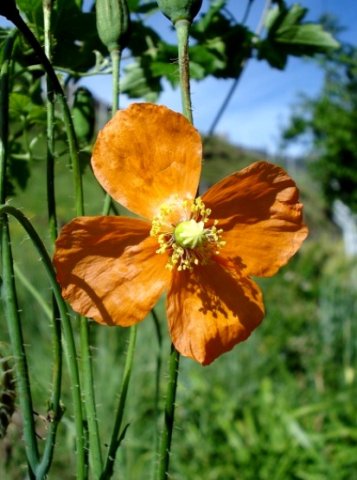Papaver aculeatum

Author: Ivan Lätti
Photographer: Judd Kirkel Welwitch
Papaver aculeatum, the orange poppy, bristle poppy or in Afrikaans the doringpapawer (thorn poppy), is an erect, tufted, prickly annual that grows to 1 m. The stems are simple or branched, densely covered in spines.
The leaves growing in a basal rosette are deeply lobed and toothed. They have stiff yellow prickles along their surfaces or along the midribs and toothing.
The flowers grow on long, erect stalks. Flowers have four broadly obovate petals forming a shallow bowl, about 5 cm in diameter. The corolla colour is orange or salmon pink. A cluster of small stamens encircle the large ovary and stigma. Flowering happens from before midspring to after mid-autumn.
The ribbed fruit is ovoid, from 1 cm to 2 cm long.
The distribution is large in the inland central to eastern parts of South Africa, while it has been reported growing in all nine provinces. The habitat is lower slopes and disturbed ground in sandy soil receiving summer rain. The habitat population is deemed of least concern early in the twenty first century.
This plant is said to be the only poppy originating from the southern hemisphere, indigenous to South Africa, Swaziland and Lesotho. The plant is also found in Australia, but it is unknown whether it has been introduced there or should be considered indigenous.
The pretty flowering plant is a weed on wheat farms. Sotho people cultivate it as a container herb. It is grown from seed (Manning, 2009; Germishuizen and Clarke, 2003; Pooley, 1998; Eliovson, 1984; iNaturalist; iSpot; www.plantgenesis.co.uk; http://redlist.sanbi.org).

